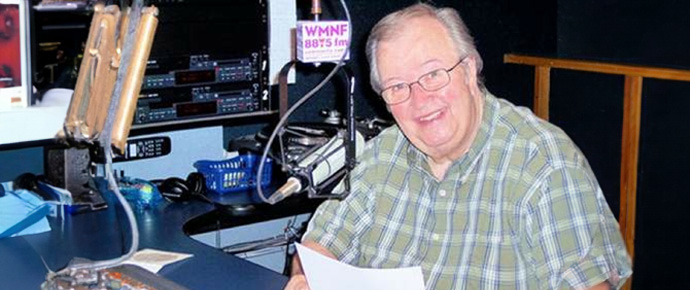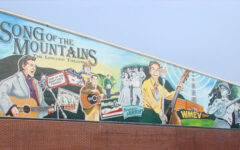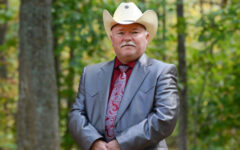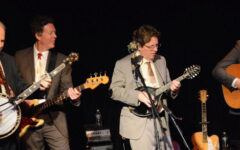
Tom Henderson touched the lives of hundreds of young bluegrass musicians during his life, and thousands more of every age through his long running radio show in Tampa, FL. We’ve already published a number of tributes to Tom since his recent passing from some of the youngsters he has mentored over the years.
Here is another from Ted Franklin Belue, history professor at Murray State University. Ted performed with Tom when he lived in Florida, and asked us to share these reflections. He is also the author of a number of books on Kentucky and Mississippi history.
 I learned late that Tom Henderson had died when a friend sent me your article in Bluegrass Today; it’s 3:00 a.m. (3/15/2014), and my conscience won’t let me sleep until I knock out a few lines of tribute to his memory. I played banjo in Tom’s Friends of Bluegrass Band (which predated his various Bluegrass Parlor Band incarnations) from November 1973 to mid-1975. His regional impact upon bluegrass—he remained the chiefest of bluegrass disciple’s and a steadfast bluegrass evangelist—cannot be exaggerated; without his efforts southeastern bluegrass, particularly in Florida, would have been far less. He exerted, I add, a lasting impact upon my own life, and was responsible for some of my happiest moments, and rather obliquely, some of my lifelong choices. Aside from some of the earlier things mentioned in your column, Tom, as the perennial bluegrass friend to youth and his Napoleonic D-28 wall-of-sound cannonades, I’ll toss in my own recollections.
I learned late that Tom Henderson had died when a friend sent me your article in Bluegrass Today; it’s 3:00 a.m. (3/15/2014), and my conscience won’t let me sleep until I knock out a few lines of tribute to his memory. I played banjo in Tom’s Friends of Bluegrass Band (which predated his various Bluegrass Parlor Band incarnations) from November 1973 to mid-1975. His regional impact upon bluegrass—he remained the chiefest of bluegrass disciple’s and a steadfast bluegrass evangelist—cannot be exaggerated; without his efforts southeastern bluegrass, particularly in Florida, would have been far less. He exerted, I add, a lasting impact upon my own life, and was responsible for some of my happiest moments, and rather obliquely, some of my lifelong choices. Aside from some of the earlier things mentioned in your column, Tom, as the perennial bluegrass friend to youth and his Napoleonic D-28 wall-of-sound cannonades, I’ll toss in my own recollections.
Tom’s Tampa-based syndicated radio show, This Is Bluegrass, was my first exposure to him, and became a mandatory weekly dose of aural communion while I was in college. To this day, his show ranked superior to any other I’ve heard (or hosted, as I had my own three-hour show, The High Lonesome Sound, on WKMS 91.3 FM, broadcasted from the campus of Murray State University, a 100,000 watt NPR affiliate). Always edgy, spanning hard-core ’46 grass to the latest thing out there, Tom featured all aspects of bluegrass, especially its people. This Is Bluegrass offered in-depth commentary and interviews not only of the greats—Bill Monroe, Lester Flatt, Ralph Stanly, Don Reno, Jim & Jesse, Charlie Waller, Ricky Skaggs, it’s a long list—but also the lesser heralded—Joe Stuart, Joe Meadows, Larry Sparks, Betty Fisher, Eddie Adcock, Sullivan Family, Chubby Wise Bluegrass Tar Heels, Little Roy Lewis, Tom McKinney, Hershel Sizemore, Wes Golding, Rual Yarbrough, Vassar Clements, and lots of sidemen, lots of local pickers.
Tom showcased the music by placing the people in a historical context, and This Is Bluegrass, always professionally done with the touch of the perfectionist bent that Tom had, ran for many hundreds of episodes. I add, he also published a monthly newsletter, wrote the articles (I wrote one, my authorial debut), did the layout and did it all quite well. All of this was done for nothing or for next to little. For Tom, bluegrass came first, last, always. That it hardly paid anything back in those pre-IBMA days was understood. That never mattered much anyway.
Tom, along with the late Ken Clark, was an early Florida bluegrass festival promoter. And even when things didn’t always run smoothly, things always seemed to, thanks to his stalwart efforts. Anyone who’s ever attempted to pull off any sort of musical show knows what logistical twists and turns these sorts of things can take. He was the ultimate bluegrass diplomat.
Tom’s house was a refuge for bluegrass folks passing through; and, he and his utterly selfless wife Chris, put up (and put up with) lots of pickers who had little to pay them back. I know because I was one of them. The year ’73-74 remains for me the worst year of my life. My father had died, things were not well at home, I was flunking college and my personal life was in tatters—Tom and Chris salvaged me, fed me, accepted my teenaged idiocy, and jolted me back to life by opening up a new world. Tom’s historical/bluegrass bent cultivated my own; Rick and Karmen, the Henderson kids, became my adopted step-siblings.
An utter greenhorn (and not at his suggestion), I quit college—my schooling was paid for but I quit anyway and have no regrets—to pick the five-string for him. By his side at festivals I found myself on Lester’s bus watching him shave with his cordless Norelco, sitting on Bill’s Blue Grass Special as he and Joe Stuart swatted out Hank Williams’ Six More Miles, hanging out with Keith Whitely, seeing Chubby Anthony and Ralph Stanley burning down a blistering backstage duet of Lee Highway Blues, meeting Fred Bartenstein, backing up Kenny Baker, John Starling bumming cigarettes off me, me bumming cigarettes off Sonny Osborne, witnessing Jimmy Martin and Carlton Haney nearly duke it out, Ben Eldrige teaching me Bill Emerson’s Cowboys and Indians, swapping George Gruhn a fiddle for Marty Stuart’s 1938 D-18 once owned by Howard “Johnny” Johnson, eating at Shoney’s with Bill and the Blue Grass Boys, and hearing Bill order “dry toast,” and the most existential blast of all, standing on stage toe-to-toe with Big Mon and Tom to play Love Come Home and Sally Goodin’. (I levitated for three days after that one, the ultimate bluegrass Big-Bang and well worth bailing out of college for.)
Tom made all that happen. And too much more to go into here, but one gets the idea. He was an oak of a bandleader, consummate MC, and put up with lots of nonsense—all for bluegrass. It needs to be underlined his wife Chris was by his side the whole time. Chris was Tom’s alter ego—patience is only one of her crowning virtues. She’s brilliant, funny, charming, a great cook, and went a long way in taking the edge off of Tom when things did not always go well and budgets were tight. I owe Tom and Chris Henderson a lot. So do a lot of folks.
In the Sunshine State—as in the Bluegrass State where I now live—there will always be a place in the sun for Tom Henderson.
Ted Franklin Belue
Department of History
Murray State University







